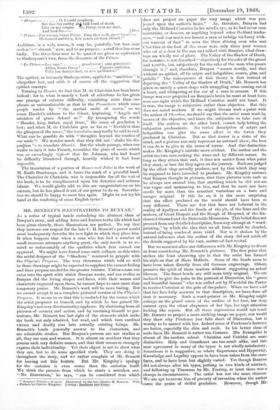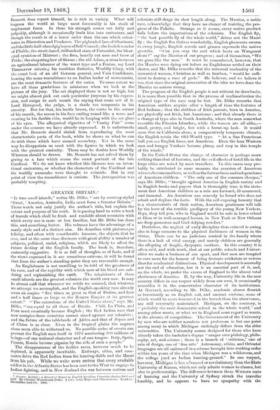MR. BENNETT'S ILLUSTRATIONS TO BUNYAN.
As a series of typical heads embodying the abstract ideas of Bnnyan's story, and adding form and feature to the life which had been given already, these illustrations are perfect. To say that they increase our respect for the late C. H. Bennett's power would most inadequately describe the new light in which they place him. It often happens that when a man who has had a number of small successes attempts anything great, the only result is to re- mind us unfavourably of the qualities which first earned our approval. We might have feared some such collapse as this when the artful designer of the " Shadows " ventured to grapple with the Pilgrim's Progress. The very cleverness which told so well in those drawings might be expected to supplant the earnest feeling and finer purpose needed for the greater venture. Unless a man can enter into the spirit with which Bunyan wrote, and can realize as Bunyan did the living shapes and faces, with their names and characters engraved upon them, he cannot hope to earn more than temporary praise. Mr. Bennett's work will be more lasting. But we cannot accept it as a complete pictorial version of the Pilgrim's Progress. It seems to us that this is excluded by the course which the artist proposed to himself, and by which he has gained Mr. Kingsley's not very discriminating applause. By abstaining from all pictures of scenery and action, and by confining himself to por- traiture, Mr. Bennett has lost sight of the elements which make the book not only admired, but read, and which turn cardinal virtue,s and deadly sins into actually existing beings. Mr. Bennett's heads generally answer to the characters, and are admirable studies. But Bunyan's persons are not studies at all, they are men and women. It is almost an accident that they possess such very definite names, and that their names so strangely express their individuality. Yet their object is not to show what they are, but to do some specified work. They are doing it throughout the story, and we rather complain of Mr. Bennett for leaving out this feature. But Mr. Kingsley's apology for the omission is even worse than the omission itself. We think the premiss from which he starts a mistaken one. "No illustration," he says, "can be considered true which • • Punpan's Pilgrim's Progress. Illustrated by the late Charles II. Bennett. With a Preface by Charles Kingsley. London : 13rapury and Eirans. does not project on paper the very image which was pro- jected upon the author's brain." As, therefore, Bunyan had
only the Midland Counties in his mind's eye, as he had never seen mountains, or demons, or anything beyond sober Bedford trades- men, "and was much too honest a man to indulge his fancy with-
out warrant of fact," as even the three shining ones who met Christian at the foot of the cross were only three poor women who at at a door in the sun and talked with Bunyan, ideal draw- ings are wholly out of place. The Valley of the Shadow of Death, for instance, is not described "objectively for the sake of the grand and terrible, but subjectively for the sake of the man who passes through it ;" and, therefore, Bunyan "names merely, and that without an epithet, all its satyr's* and hobgoblins, snares, gins, and pitfalls." The consequence of this theory is that instead of depicting the "Valley of the Shadow of Death," Mr. Bennett has given us merely a queer BUN with straggling arms coming out of a heart, and whispering at the ear of a man in armour. If this image was ever projected on Bunyau's brain he must at least have seen one sight which the Midland Counties could not boast. It is true, the image is subjective rather than objective. But this does not mend matters. If we might discuss such a point with the author of Phaethon, we should say that the artist must work by means of the objective, and leave the subjective to take care of itself. The author, on the other hand, cannot help letting the subjective predominate. No verbal description of satyrs and hobgoblins can give the same effect as the terror they produced in Christian. But as that terror is a state of the mind, and a picture can only represent an outward show, the best it can do is to give us the cause of terror. And this distinction makes Mr. Kingsley's mistake more evident. The author and the artist are two men seeking the same end by different means. So long as they attain that end, it does not matter from what point they start, or how far they agree on the journey. Both are judged by the effect they actually produce, not by that which they may be supposed to have intended to produce. Mr. Kingsley assumes that Bunyan thought in pictures, that these pictures were such as he always saw around him, that anything which he did not see was vague and unmeaning to him, and that he must not have credit for more than the scantiest variations on a bare and meagre original. If this be so, it is the more surprising that the effect produced on the world should have been so very different. There are few that have not believed in the reality of Apollyon and the fiends of the pit, of the lions and the archers, of Giant Despair and the Slough of Despond, of the En- chanted Ground and the Delectable Mountains. This belief does not proceed from any detailed description, from any attempt at "word- painting," by which the idea that we all form would be clouded, instead of being rendered more vivid. Nor is it shaken by the natural inference that the author of the story did not catch all the details suggested by his curt, matter-of-fact recital.
But we must not allow our differences with Mr. Kingsley to divert us from considering Mr. Bennett's pictures. The first point that strikes the least observing eye is that the artist has formed his style on that of Hans Holbeiu. Some of the heads seem to have been taken directly from old German engravings. Others preserve the spirit of those masters without suggesting an actual likeness. The finest heads are still more truly original. We are inclined to give the palm to the portrait of Discretion, the "grave and beautiful damsel" Who was called out by Watchful the Porter to receive Christian at the gate of the palace. When we have said that her face fully answers to that description, we have done all that is necessary. Such a word-painter as Mr. Kingsley might enlarge on the grand curve of the outline of her face, her deep earnest eyes, the silent eloquence of her lips, her rapt attention looking like repose. But all those expressions would not teach Mr. Bennett to project a more striking image on paper, nor would they show why Prudence just falls short of Discretion, but is worthy to be named with her. Indeed some of Prudence's features are better, especially the chin and neck. In his better class of male faces Mr. Bennett is rather too German. His Evangelist is almost of the modern school. Christian and Faithful are more distinctive. Help and Greatheart are too much alike, and this near agreement in many of the types is not wholly satisfactory. Sometimes it is suggestive, as where Experience and Hypocrisy, Knowledge and Legality appear to have been taken from the same faces, and to have been but slightly varied. Yet though Bunyan did not always alter his types, putting in two kinds of mistrust, and following up Timorous by Mr. Fearing, at least there was a change in circumstances. The artist has not the same chances. We are apt to accuse him of poverty of invention when the author earns the praise of skilful gradation. However, though Mr.
Bennett does repeat himself, he is rich in variety. What will impress the world at large most favourably is his stock of unpleasant faces. In these his strength comes out fully and palpably, although it occasionally leads him into caricature, and though the result is of a lower order than the one which cultni- Dates in Discretion and Prudence. The pigheaded face of Obstinate; and thelittle half-closed pig's eyes of Self-Conceit ; the foolish wonder of Pliable, the strait-laced, stiffnecked stare of Formalist, the blear. eyed cynicism of Mistrust ; the firm, heavily cut nose and brow of Pride ; the simpering leer of Shame ; the old Adam, a cross between an agricultural labourer of the worst type and a Fenian, my Lord Timeserver uttering his toothless flatteries, Worldly Glory, with the exact look of an old German general, and Vain Confidence, bearing the same resemblance to an Italian leader of mercenaries, are the most dramatic features of the series. To some extent we have all these gradations in . miniature when we look at the picture of the jury. The art displayed there is not so high, but we might almost pick out each particular jurymau by his expres- sion, and assign to each mouth the saying that came out of it. Lord Hategood, the judge, is a shade too temperate in his atrocity. But for that, his beetle brows, the curve in the corner of his mouth, the seams in his face curling round like a wave and cresting in his double chin, would be in keeping with the set glare of his eyes. The allegorical vignettes of "Vanity Fair" come under the censure we have already expressed. It is unfortunate that Mr. Bennett should shrink from reproducing the most characteristic parts of the book, while he shows us what he can do with those which have seemed secondary. Yet in the same way he disappoints us most with the figures to which we look with the greatest curiosity. There may be doubts how Worldly Wiseman should he drawn. Mr. Bennett has not solved them by giving us a face which seems the exact portrait of the late Cardinal. We do not know whether this likeness was an inten- tional caricature, or whether the characters of the Cardinal and his worldly namesake were thought to coincide. But in any point of view the resemblance is curious. The juxtaposition was probably tempting.







































 Previous page
Previous page